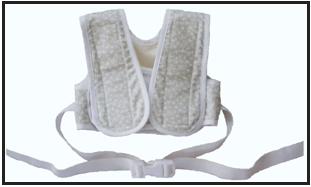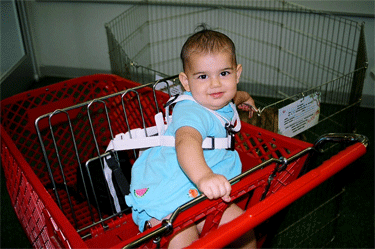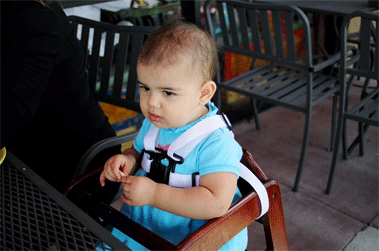Eliminate The Diaper Changing Struggles
Hug ‘n’ Hold is a secure, easy to use restraint to hold a baby or toddler safely on a diaper changing pad, keeping them from rolling away or escaping during diaper changes.

- It eliminates the diaper changing battles.
- Adds an extra level of security when you are reaching for the diapers and wipes.
- No more accidents of baby falling off the changing table when you didn’t know that she could roll yet.
- Acts like extra hands to hold a baby’s shoulders down on the changing pad.
- Keeps your hands free to do the dirty work of diaper changing.
- Works on changing stations in public bathrooms.
- How does it work?
How The Hug N Hold Works

- Inhibits rolling at the shoulder level.
- The Hug ‘n’ Hold needs a stiff backed changing pad to be attached to. Cardboard can be used to stiffen the back.
- The weight of the child on the pad in combination with the vest and solid back of the pad keep the child from rolling.
- The Hug ‘n’ Hold buckles around the back of the pad or table.
- It fastens around the child using hook and loop(velcro), and has two chest straps that fasten in front of the child, and two shoulder straps that come up and over the shoulders and fasten onto the chest strap to act as a 4 point harness.
- The Hug ‘n’ Hold is not meant to be used as a safety device, and is no substitute for parent supervision.
- Never leave child unattended.
- Pad not included.
As a pediatric Occupational Therapist, I have a strong knowledge of kinesiology and positioning of children to help them achieve the function that they need to achieve. Along with this training comes the knowledge of where to hold a child to inhibit movements that need to be avoided. I have developed the Hug N Hold to incorporate these body movement principles. The device’s structure is like a vest, and the straps originate from behind the child so that it is in contact with the child at all times. The child is unable to rotate or
slide up or down inside the vest-like straps.
I have seen other straps that originate on the outer portion of a changing pad, which gives the child space to wiggle free, or turn over. Others I have seen make a cross over the child’s chest, which can be dangerous because if the child wiggles down, it could potentially choke or strangle the child.
Keep your baby safe,use the Hug ‘n’ Hold.
About the Hug N Hold
Hug N Hold was created by Tonya Cooley. I am the mother of two, and am also a pediatric Occupational Therapist. Once my youngest son, Conor, learned to crawl, he was very resistant to holding still and having his diaper changed. I would sit with him on the floor in front of me and hold his shoulders down with my feet while gripping with my toes. My toes would cramp, and he would still get away. He just considered it a challenge. I searched for something in stores that would make it easier, but was unable to find anything. I then created a strapping system that worked well with my son. I decided that if I needed this, others most likely did too, so I made it easier to use, and that is how the Hug N Hold was born. I would love to hear any comments that you might have.
How The Hug N Hold Works
- Inhibits rolling at the shoulder level.
- The Hug ‘n’ Hold needs a stiff backed changing pad to be attached to. Cardboard can be used to stiffen the back.
- The weight of the child on the pad in combination with the vest and solid back of the pad keep the child from rolling.
- The Hug ‘n’ Hold buckles around the back of the pad or table.
- It fastens around the child using hook and loop(velcro), and has two chest straps that fasten in front of the child, and two shoulder straps that come up and over the shoulders and fasten onto the chest strap to act as a 4 point harness.
- The Hug ‘n’ Hold is not meant to be used as a safety device, and is no substitute for parent supervision.
- Never leave child unattended.
- Pad not included.
As a pediatric Occupational Therapist, I have a strong knowledge of kinesiology and positioning of children to help them achieve the function that they need to achieve. Along with this training comes the knowledge of where to hold a child to inhibit movements that need to be avoided. I have developed the Hug N Hold to incorporate these body movement principles. The device’s structure is like a vest, and the straps originate from behind the child so that it is in contact with the child at all times. The child is unable to rotate or
slide up or down inside the vest-like straps.
I have seen other straps that originate on the outer portion of a changing pad, which gives the child space to wiggle free, or turn over. Others I have seen make a cross over the child’s chest, which can be dangerous because if the child wiggles down, it could potentially choke or strangle the child.
Keep your baby safe,use the Hug ‘n’ Hold.
See us on the Today Show
As a Grocery Cart Support
Also works well as a support/restraint in a shopping cart or restaurant high chair.
Help with sitting
- Works well with children who have poor sitting balance, and are delayed with their muscle control.
- Always supervise children. Older children can unfasten the velcro.
Just put the Hug ‘n’ Hold on to your child, and fasten the back strap with the buckle through the slats on a grocery cart seat. Tighten the straps, and the Hug ‘n’ Hold will keep your child from falling over, falling forward, or trying to stand up in the cart seat.


Who Needs One
Babies who try to escape during diaper changes
Every baby goes through a stage where they don’t want to lie still when having their diaper changed. Some are easily redirected and distracted so that the job can get done relatively easily. Others are more strong willed, and every diaper change is an exhausting battle that uses up your creativity for distracting activities, and pushes your physical limitations.
We are all born with only two hands, and some babies require three to four hands to change their diaper. The Hug ‘n’ Hold acts like extra hands to hold a baby’s shoulders during diaper changes. It is made of soft cotton flannel so it is comfortable, and it is easy and quick to fasten.
When you start using it with a baby who is just beginning to roll, or even before it learns to roll, the baby just accepts it as something that is put on when its diaper is being changed, and does not fight it very much. When you start using it with a baby who has been crawling and walking, and is used to being able to escape, then they will fuss about having the Hug ‘n’ Hold used, but will get used to it and accept it when they realize they can’t get away. Some older children get really mad when the Hug ‘n’ hold is used for the first time because it is keeping them from doing what they want to do, which is escape. Eventually they get used to it, and it becomes a good behavior modification tool to get the child to lie still.
When they get close to two years old, they can understand cause and effect, and understand that if they try to get away, the Hug ‘n’ Hold will be put on, but if they lie still, they can keep it off.
Accidents with babies rolling off the changing table
Babies learn to roll over between three to five months old. Some begin as early as two months old. There are so many stories from parents who say that they took their hands off their baby for just a second to grab something that fell off the changing table, and their baby fell off the changing table. I have also heard stories from parents saying that they did not know that their baby knew how to roll yet, and he rolled right off the table with the parent right there, but unable to grab him. Then there are the babies who can not roll yet, but they manage to push with their legs, and scoot off the top of the table on to their heads. It seems that changing a baby’s diaper can be a dangerous business.
The Hug ‘n’ Hold solves these problems with it’s vest-like shape which goes over the chest and over the shoulders. It keeps a baby snug in position. When use of the Hug ‘n’ Hold is started when a baby is young, they just accept it as part of their normal routine. The Hug ‘n’ Hold should not be used strictly as a safety device, and is no substitute for parental supervision. A child should never be left unattended. It is meant to help the parent as extra hands, not to be the parent.
Children with disabilities
Many children with disabilities have poor motor movements, or very random movements that they are unable to control. In some situations this can be potentially dangerous to the child with potential for injury. The changing stations in public restrooms are one example of a potentially dangerous situation. The Hug ‘n’ Hold fits onto most public changing stations and makes them a little bit safer.
Some children have poor sitting balance and may hurt themselves if they are in a shopping cart seat, so their parent is not able to go grocery shopping with them. The Hug ‘n’ Hold works in shopping carts by putting the vest part onto the child, and strapping the back strap onto the back of the seat. The chest part holds the child’s shoulders back so that they don’t fall to the front or to the sides. It also helps the child develop his sitting balance and improve his muscle strength by giving him some movement to the sides and front, and the child then has to use his own muscle control to bring himself back up. It keeps the child upright, and keeps him from hurting himself, but lets him play with a little bit of movement.
Other children with disabilities do not understand cause and effect, and take longer to understand a parent’s directions. They may also be harder to distract with toys due to a lack of interest in toys. The Hug ‘n’ Hold is helpful for changing these childrens’ diapers as you cannot reason with them, and they do not understand cause and effect. It can work well as a behavior modification tool. If the child is old enough and strong enough though, he will be able to unfasten the velcro on the Hug ‘n’ Hold. We will be happy to modify them as needed for children with special needs using buckles to keep it safer and easy. Again, children should not be left unattended.
Parents with disabilities
Many parents have physical conditions that make it hard to hold a struggling baby down to change its diaper. Some of these conditions could be Arthritis, Muscular Dystrophy, Spinal Cord Injury, Head injury, Cerebral Palsy, or any other condition that weakens or decreases muscle control. Changing a wiggly child’s diaper is difficult for a strong, able bodied person, and when you have other strength and coordination problems it can be a very daunting task. The Hug ‘n’ Hold acts as extra hands to help you hold on to the child so that your strength can go into changing the diaper instead of holding the child down. Again, the child should never be left unattended.
